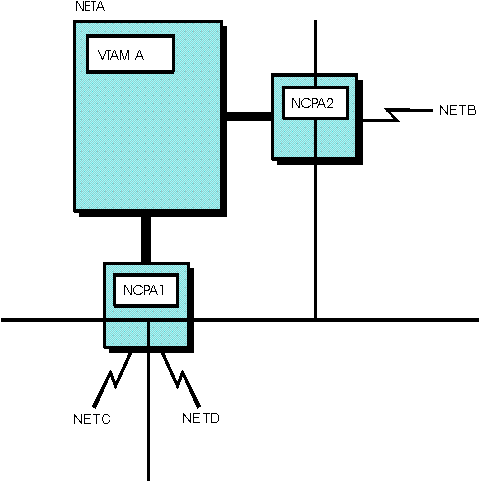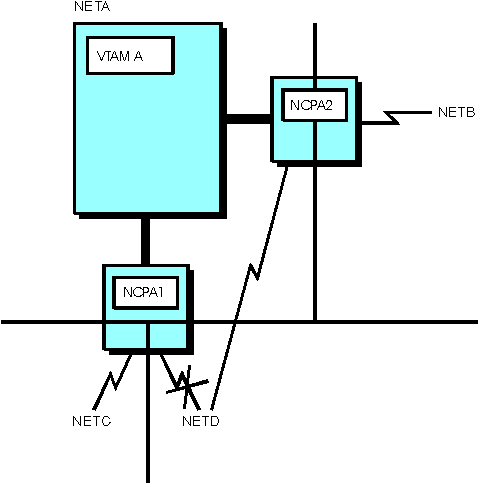Following is the coding for the backup gateway NCP (NCPA2):
DNETID BUILD VERSION=V5R4,
⋮
GLS GROUP LNCTL=SDLC,ACTIVTO=420.0,TYPE=NCP,DIAL=NO,REPLYTO=3, *
SDLCST=(STPRIM,STSECD),PUTYPE=4, *
NETID=(NETA,ANY)
LLS LINE ADDRESS=(10,FULL), *
DUPLEX=FULL, *
⋮
PLS PU PUTYPE=4,TGN=18, *
RETRIES=(,2,0)
GSW GROUP LNCTL=SDLC,ACTIVTO=0,DIAL=YES,REPLYTO=3,PUTYPE=4, *
SDLCST=(STPRIM,STSECD),V25BIS=(YES,DLSDLC), *
NETID=(NETB,ANY)
LSW LINE ADDRESS=(035,FULL), *
⋮
NETB NETWORK SUBAREA=9,NUMHSAS=12,NETID=NETB, *
PATHEXT=2,TGBXTRA=3
GWNAU ELEMENT=6,NETID=NETA,NAME=SSCPA,NUMSESS=4
GWNAU NUMADDR=7
PATH DESTSA=19, *
ER0=(19,1),ER1=(19,1),ER2=(19,1),ER3=(19,1), *
ER4=(19,1),ER5=(19,1),ER6=(19,1),ER7=(19,1), *
VR0=1,VR1=1,VR2=2,VR3=3,VR4=4,VR5=5,VR6=6,VR7=7
PATH DESTSA=(8,18), *
ER0=(8,36),ER1=(8,36),ER2=(8,36),ER3=(8,36), *
ER4=(8,36),ER5=(8,36),ER6=(8,36),ER7=(8,36), *
VR0=1,VR1=1,VR2=2,VR3=3,VR4=4,VR5=5,VR6=6,VR7=7
COPIES NETWORK SUBAREA=5,NUMHSAS=12,COPIES=6, *
PATHEXT=6,TGBXTRA=5
GWNAU ELEMENT=8,NETID=NETA,NAME=SSCPA,NUMSESS=3
GWNAU ELEMENT=15,NETID=NETB,NAME=SSCPB
GWNAU NUMADDR=8
PATH DESTSA=15, *
ER0=(15,3),ER1=(15,3),ER2=(15,3),ER3=(15,3), *
ER4=(15,3),ER5=(15,3),ER6=(15,3),ER7=(15,3), *
VR0=1,VR1=1,VR2=2,VR3=3,VR4=4,VR5=5,VR6=6,VR7=7
PATH DESTSA=24, *
ER0=(24,18),ER1=(24,18),ER2=(24,18),ER3=(24,18), *
ER4=(24,18),ER5=(24,18),ER6=(24,18),ER7=(24,18), *
VR0=1,VR1=1,VR2=2,VR3=3,VR4=4,VR5=5,VR6=6,VR7=7
GENEND GENEND
END
Notes: - Omit the NETID operand from the NETWORK definition statement.
- Ensure that you have PATH definition statements defined for all
the adjacent subareas. Thus, for the above coding, the adjacent subarea
in NETD must be either 15 or 24.
 z/OS Communications Server: SNA Network Implementation Guide
z/OS Communications Server: SNA Network Implementation Guide
 z/OS Communications Server: SNA Network Implementation Guide
z/OS Communications Server: SNA Network Implementation Guide





 Copyright IBM Corporation 1990, 2014
Copyright IBM Corporation 1990, 2014